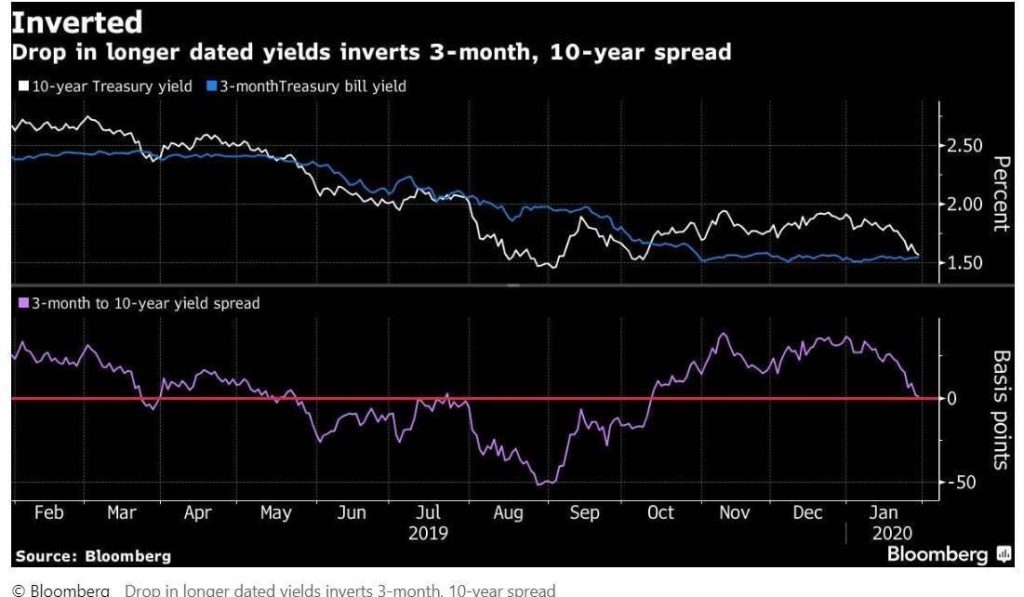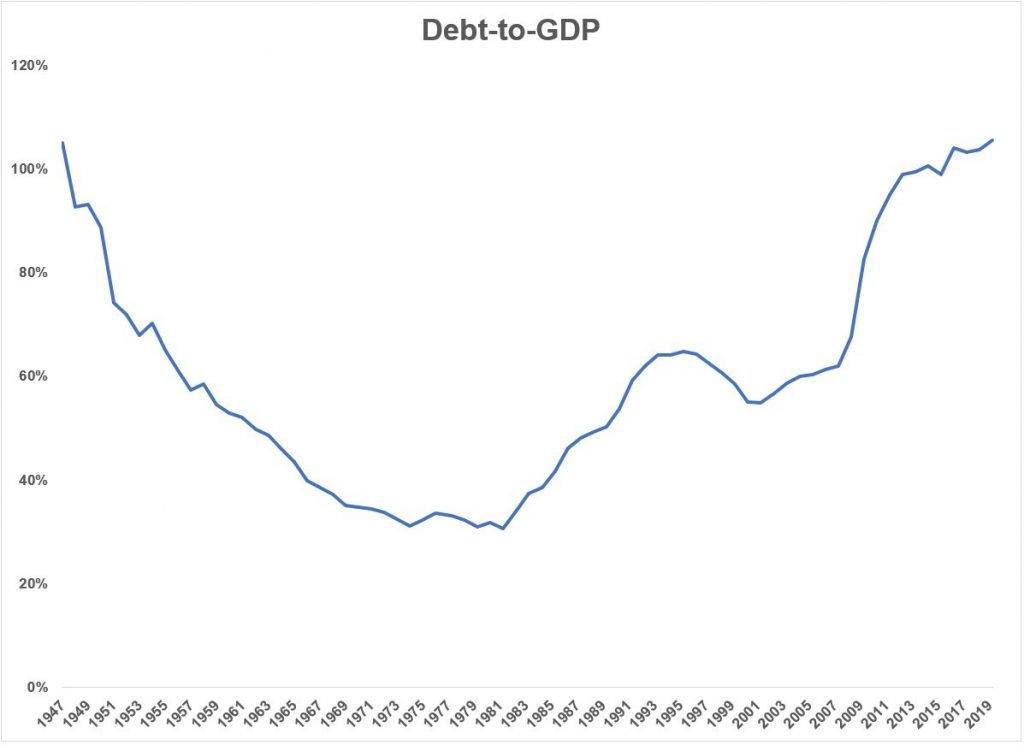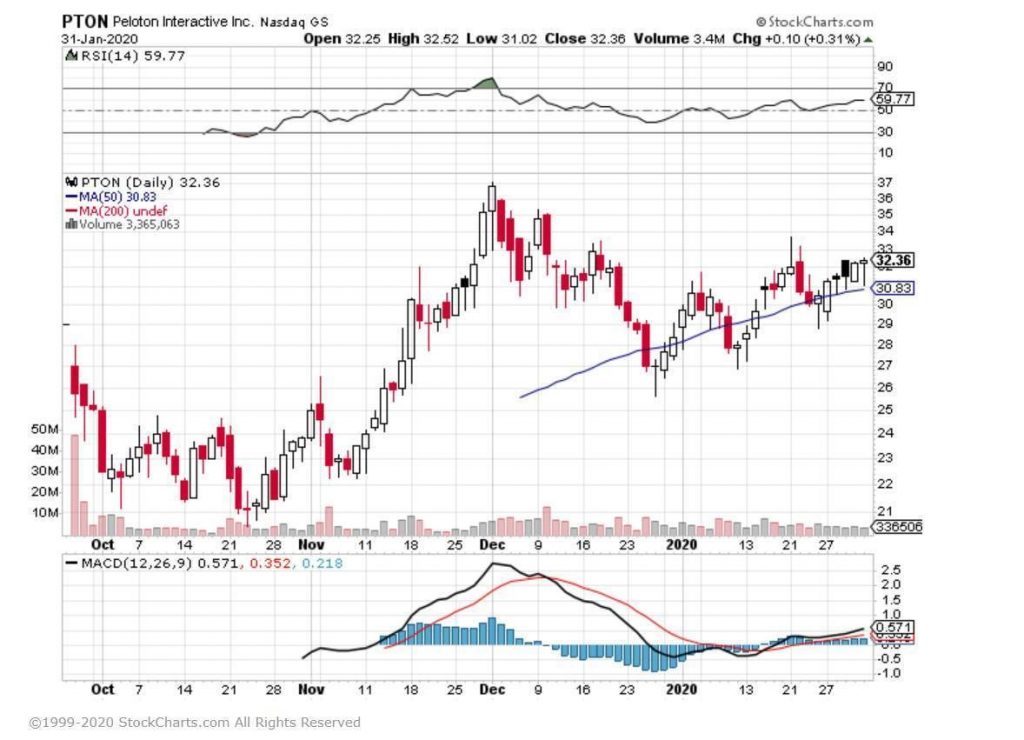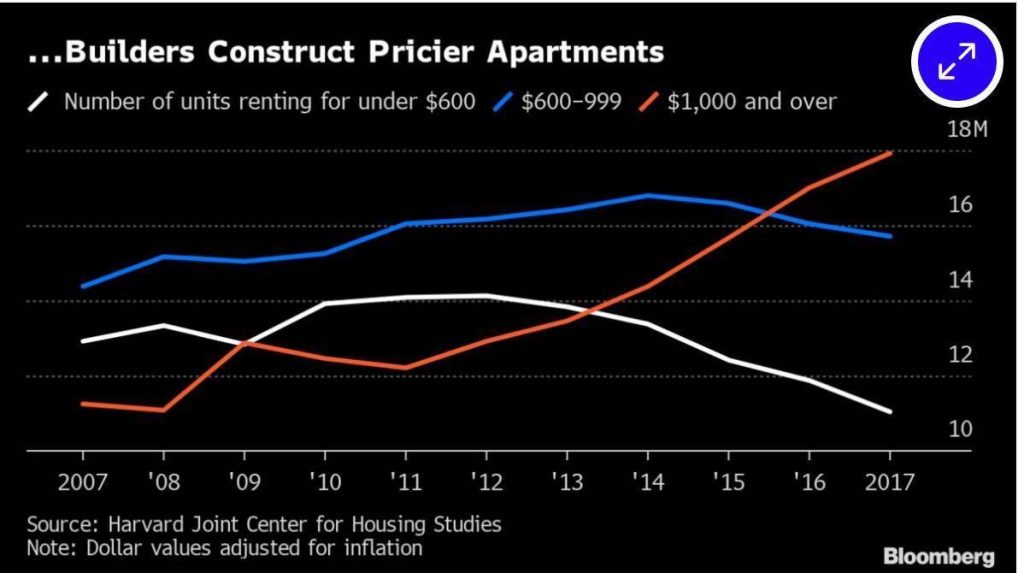1.The 10 Largest Companies in the S&P Have a Combined Market Cap of More Than 3x the Entire Russell 2000 Index.
The march higher took on a familiar feel as larger names continued to outpace smaller. The pull of large companies has become so strong that, as shown [below] [to the right], the 10 largest companies in the S&P 500 have a combined market cap of MORE THAN 3X THE ENTIRE RUSSELL 2000® INDEX of small companies. This type of stampede into pricey mega-caps has historically ended poorly for those who followed the crowd.

2.Overnight Crude Oil Down 22% from Jan. 8th Peak.
Predictably, the plunge in Chinese oil demand is already reverberate across the global energy market, with sales of some crudes slowing to a crawl, tanker rates crashing and benchmark prices in free-fall, with Friday closing price about 14% lower since Jan 20 when the world first started focusing on the China pandemic… a free fall which only accelerated after the Bloomberg report which sent Brent tumbling on Sunday night, and which has just entered bear market territory, plunging over 22% since its January 8 peak.

3.Yield Curve Re-Inverts.
A key slice of the U.S. yield curve inverted on Thursday for the first time since October, reviving memories of growth fears that plagued investors last year and signaling doubts that the Federal Reserve will succeed in reviving inflation.

The inverting yield curve is about more than recession this time
4.When Does the Federal Deficit Matter?
Posted February 2, 2020 by Ben Carlson
This week the Congressional Budget Office put out a forecast that the federal budget deficit will hit more than $1 trillion.
According to the U.S. Treasury, federal debt levels are already more than $22 trillion.
A trillion here or there and the CBO is expecting more than $31 trillion in debt by the end of the decade.
People are worried about this situation but people have been worried about this situation for decades.
The question is when does this matter? When will this situation ever become too unsustainable? Are we really screwing over the grandkids with all this debt?
Well, it depends.
The first thing to understand about the deficit is the U.S. government is nothing like a household. They don’t need to pay off all this debt down to a zero balance as you do with your mortgage.
The U.S. government has the ability to tax the largest, most dynamic economy in the world along with the world’s reserve currency.
And as long as the economic pie continues to grow we should expect the debt to grow as well.
Here’s your crazy but true stat of the day: Since 1947, U.S. government debt has grown at an average annual rate of roughly 6.3%. And nominal GDP in American has also grown at an annual rate of roughly 6.3%.
You can see the growth of both here:

Government debt is just over $22 trillion while GDP is just under $21 trillion. These variables don’t necessarily make for an apples-to-apples comparison but they at least belong in the same fruit basket.
Now here’s debt as a percentage of GDP which is one of the things that worries many economic thinkers:

The reason this number was so high at the outset of this chart is because of WWII. We’re not exactly in a situation like that today where it’s completely necessary to borrow and spend as much as possible.
FULL READ
https://awealthofcommonsense.com/2020/02/when-does-the-federal-deficit-matter/
5.80% Of Peloton Shares Sold Short.
Recently, 80% of the Peloton shares available for trading were sold short, meaning investors sold borrowed shares to bet on a drop in the stock price. Only two companies in the Russell 3000 index had higher short-selling interest: GameStop (GME) and Health Insurance Innovation (HIIQ), according to Bloomberg research.
Peloton’s Earnings Could Settle the Debate: Keep Buying the Stock, or Sell ShortBy Connor Smith

6.PWC CEO SURVEY


https://www.pwc.com/us/en/services/deals/ceo-views-on-deals.html
7.High-Income Households Drove More Than Three-Quarters of Growth in Renters 2010-2018
What’s more, an influx of high-income renters –- mainly young, married, white, and college-educated –- are increasingly delaying home ownership either out of choice or necessity, driving up rents by fueling competition for existing units and spurring new construction designed primarily for the upper end of the market.
High-income households drove more than three-quarters of growth in renters from 2010 to 2018, bringing the share of people earning at least $75,000 to a record, the researchers’ analysis of inflation-adjusted Census data show. The share of low-cost units in the national rental stock shrank to 25% in 2017 from 33% in 2012 — with the biggest declines in Iowa, Montana, Nebraska, North Dakota, Oklah

The U.S. Housing
Crisis Is Making Its Way to the Heartland Jordan Yadoo Noah Buhayar
Read more at: https://www.bloombergquint.com/business/the-u-s-housing-crisis-is-making-its-way-to-the-heartland
Copyright © BloombergQuint
8.Bloomberg campaign spent more than $188 million in one quarter
Stef W. Kight, Alexi McCammondJan 31, 2020
Michael Bloomberg’s 2020 campaign spent more than $188 million in just the last quarter of 2019, according to new FEC data.
Why it matters: Bloomberg didn’t officially announce his presidential bid until late November. But in one quarter, his campaign spent more than twice as much as Sen. Bernie Sanders’ campaign spent in all of 2019 — $89.9 million.
The big picture: Bloomberg’s spending has the potential to shift the dynamics of the race. While other candidates worry about fundraising enough to stay afloat, the multi-billionaire will be able to fund his campaign almost indefinitely.
- “Our first month’s filing represents a down payment and commitment in all 50 states to defeat Donald Trump, and it shows we have the resources and plan necessary to take him on,” Bloomberg campaign manager Kevin Sheekey said in a statement.
By the numbers: Of the $188 million dollars spent, $132.2 million was spent on TV advertising, according to a campaign aide.
- $8.19M was spent on digital advertising
- $3.3M on polling
- $1.5M on rent
- $757K on airfare including $646K in private plane use
- $161K on hotels
Go deeper: DNC’s new debate rules open the door for Bloomberg
9.Sleeping on your stomach: Is it bad for you?
Updated: December 20, 2019 – 8:00 AM
Heather Moore, For The Inquirer | @totalppt

Stomach sleepers often insist that they are unable to sleep in any other position. But, changing your sleeping position is essential, as sleeping on your stomach can be the cause of neck, back, hip and shoulder pain and even headaches.
In order to sleep on your stomach, you must turn your head in one direction to be able to breathe, leaving your neck in constant rotation throughout the night. This causes diminished blood flow to the head and neck, which can cause headaches and other pain.
If you must sleep on your stomach, there are pillows with holes in the middle that will allow your neck to stay straight while you sleep.
Another problem with stomach sleeping: In order to raise your head and shoulders enough to breath you need to have an arch in your lower back. This causes compression in the spine and does not allow for proper alignment of ligaments, muscles, bones and joints. If you wake up with a stiff back or sharp pain in your back or numbness and tingling in your legs or feet, stomach sleeping may be to blame.
You can alleviate these aches by placing a pillow under your stomach. Just make sure the pillow is thick enough so that you have a neutral spine. (This may require more than one pillow.)
Sometimes people will sleep with a leg up to the side — what I call a “three-quarter position” — and not really consider it stomach sleeping. Although this position is better than stomach sleeping because it does take pressure off the lower back, it can instead put extra pressure on the hip. To sleep in that position correctly you want to put several pillows under your stomach so that you are almost sleeping on your side.
Stomach sleeping and the three-quarter sleeping position also encourage you to have your arms overhead when sleeping. This puts tremendous pressure on your shoulders and the surrounding nerves. Waking up with hands that are asleep or shoulders that are in pain is a very big sign that you are causing injury to yourself. Even if you can shake off the pain quickly in the morning, overtime it can become a greater issue.
Then how should you sleep?
Lying on your back is the best position to sleep, followed by lying on your side. But even in those positions, there are steps you need to take to set yourself up with correct posture.
When lying on your back, you don’t want to be completely flat, as that will cause a slight arch in your back. Place two or three pillows underneath your legs to put your spine in a neutral position. You also want to make sure that your pillow allows your head to lie flat.
When lying on your side, consider a side sleeper pillow that will fill the size of your shoulder to ensure that your neck is in a neutral position. You do not want to use two pillows, as they can slide and cause you to shrug your shoulders in order to keep them in place, ending in neck and shoulder pain. Also, put a pillow between your knees to ensure a neutral spine. And if you have shoulder soreness or pain, hugging a pillow will help by allowing increased blood flow to the shoulder.
Although it is very hard to change how you sleep, it is important to start trying. Even just falling asleep in the proper position, but shifting throughout the night, can save you and your body some unwanted aches and pain.
Heather Moore is the owner of Total Performance Physical Therapy in North Wales, Norristown and Hatfield, Pa.
10.What Brings Meaning and Purpose in Life?
Ongoing research helps uncover clues as to what shapes meaning in life.
What Brings Meaning and Purpose in Life?
Happy New
Year from the Human Flourishing Program! One of the ongoing
research projects of the Human Flourishing Program at Harvard is to understand
better what gives rise to a sense of meaning and purpose in life. With the new
year dawning, and New Year’s resolutions in place, or perhaps still being
formed, it seemed a good time to have an update on our research on this topic.
There has been recent increased interest in meaning and purpose. For example, a
group of researchers at the University of Michigan published a paper last year that
indicated there were considerable longevity benefits to having a sense of
purpose in life for adults above age 50, and this study created a substantial
media buzz.
Our own research on the topic was published last year in the American Journal of Epidemiology. We examined the role that having a sense of purpose played among 6,000 young adults in the Growing Up Today Study (GUTS) by investigating those who affirmed having experienced a sense of mission in life. The participants were assessed in adolescence and followed up for six years into early adulthood. We wondered whether and how having such a sense of mission would affect other aspects of health and well-being.
What we discovered about purpose
As in previous analyses, our study controlled for a rich set of other potentially confounding factors, including numerous social, demographic, and economic characteristics, parental variables, including maternal attachment, participation in religious services, and also prior values of the outcome variables whenever available. Even after such control, there was evidence that, over time, a sense of mission subsequently improved flourishing in numerous domains, including happiness and psychological well-being (e.g., life satisfaction, positive affect, self-esteem, emotional processing, and emotional expression), promotion of physical health (greater use of preventive health care), possibly mental health (fewer depressive symptoms), and character (more volunteering).
Although we did not find associations with specific physical health outcomes in our study, it must be remembered that this was a relatively young group of participants (essentially in their 20s during the study follow-up), and major health problems usually begin later in life. And again, prior research from the group at the University of Michigan indicated substantial health benefits (greater longevity) among older adults. Clearly, having a sense of purpose matters. It matters for its own sake, and it matters for affecting other aspects of health and well-being.
What gives rise to a sense of meaning and purpose?
Remarkably little longitudinal research over time has been carried out on this question of what actually shapes meaning and purpose in life. Our program is trying to remedy that. In our analyses with the Growing Up Today Study, we found that religious service attendance, maternal attachment, and volunteering during late childhood were among the strongest predictors of subsequently having a higher sense of purpose during adolescence; marijuana use and depression tended to lead subsequently to lower levels of purpose.
Although there is certainly a need for replication in other settings, these initial analyses may help provide guidance for parents trying to shape a sense of mission and purpose for their children. At the policy level, many of the debates around marijuana legalization have focused on questions of health effects, but perhaps issues concerning the formation of purpose in life should come into play as well.
Some of our current research is also examining similar associations concerning the determinants of purpose among older adults. What we have found thus far is that purpose in life seems to be somewhat less malleable later in life than it is in adolescence and young adulthood. Although we will report more fully when our research papers are out, it seems that volunteering, in particular, has one of the largest effects on increasing purpose in life among middle-aged and older adults. But we still have more work to do.
It is clear that more research needs to be done on this important topic. Almost everyone desires to have a sense of meaning and purpose in life. The fact that we know so little, at least empirically, about what gives rise to such meaning and purpose is truly remarkable.
A New Measurement Tool
To facilitate a more careful study of the determinants of meaning and purpose, we recently introduced a new measurement tool: the Comprehensive Measure of Meaning. This measure is intended to incorporate important philosophical insights into existing psychological approaches that suggest meaning is experienced along three dimensions: cognitive coherence (having a sense of the “meaning of life”), affective significance (having a sense of “meaning in life” in one’s activities), and motivational direction or purpose (having important goals and pursuits). The Comprehensive Measure of Meaning makes use of a variety of items from previous scales, but it categorizes these in ways that are consistent with important distinctions in the philosophical literature.
We have collected data concerning the measure on a sample of over 4,000 undergraduates at the University of British Columbia and are beginning to assess its psychometric properties and to incorporate it into other datasets as well. Its use by other researchers is also most welcome. We hope that by building these new data resources, we will, over time, come to a more comprehensive understanding of what gives rise to a sense of meaning and purpose in life. We will keep you updated!